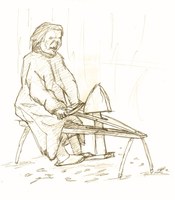2012 Lecture for in Saint Cécile of Aladfi Samoën on "forgotten techniques"
These included the
- - "Free Aufschachteln" rib construction method: The ribs are assembled without using a mold into a wooden tun ring.
- - "Pull the bulge": The curvature (ceiling or floor, a string instrument) is pre works with various crowbars on the cutting-board.
- - "Working out of the bass bar on unlimited": The bass bar is available when working out the ceiling left, bass bar and ceiling are made of one piece glue joint between the bass bar and ceiling.
These home workers generally obtained their source material (frames, tonewood) of the publishing houses (trading houses) and delivered the finished Instrumentenkorpusse back to this. Many of the publishing houses were removed in the 8km, on the other side of the Bömisch - Saxon border situated Marktneukirchen resident. Everyone in the family home of working class families had a specific task in the manufacturing process, therefore, there was a very streamlined work - but also a certain monotony. The economic situation of home workers' families was difficult from the very beginning. This explains that the work was carried out before the first world war by hand and can not be invested in expensive machinery. The home workers were self-employed were not bound by fixed contracts to a particular publishing house. They had their work results in competition with other home workers offer the Publishing houses.

Fig 1: heel bar
1904 by engineer William Thau from Klingenthal a patent pending for a machine for fully automated milling string instrument ceilings and floors. The market was established in 1906 in Neukirchen Aktiengesellschaft for violin industry was with the use of this patent in direct competition with the working on the other side of the border home workers. (Source: Weller, Enrico. Industrialist violin in the first half of this century - the corporation for violin industry in Marktneukirchen, instrument - Journal P. 53.7 / 8 (1999) 22-25) This led to the fact that the home worker technique her with the offer the "bulge pulling" string instrument made ceilings and floors had even cheaper. This enabled the corporation to work until the First World War hardly economical.
To "buckle pulling" stretched to the grooved top plate (spruce) or baseplate (maple, poplar, rarely other woods) in the cutting-board. Passing a foot pedal was the workpiece can be fixed. As that one sat on the cutting-board and took the foot pedal, you could put the power of the whole body perfectly into a pulling the benefits of cutting-board. The craftsman both hands were free for the tool guide and the craftsman could turn by releasing and pressing the foot powder, the workpiece quickly and turn (Fig. 1). Home workers used basically 3 crowbar: a straight and two with a rounded edge (Fig. 2). The production of the curvature of a violin or fiddle floor ceiling was in 5 steps (Fig. 3):

Fig 3: workflow
- The straight crowbar was the height of the curvature of the lower and peeled - and Upper bout preferred.
- With two rundangeschliffenen crowbar the C-frame drawn (Mitt Elber realm of violin) and the marginal area drawn as ready that he stayed at a thickness of 5-7 mm.
For these two processes, which includes the installation of the arch, needed a home worker for 2-3 minutes. - The outline of the violin ceiling - the violin land is divided to finish and engraved with the Randholhkehle, a gouge.
- With small curvature planing the transition from the chamfer is planed for the curvature and irregularity in the curvature compensated.
- "Brushing" the vault: The tool used for this fine work was mainly on the quality of work expected results depends (scraping, sanding disc) .
At the end of my presentation, I will briefly discuss the technique of bass bar "from the solid." After eyewitnesses, this technique was used only for instruments from the lowest quality segment. I recently had a good sounding and cleanly crafted violin for repair, the bass bar one "on unlimited" had. One can clearly see the stitch marks from working out of the ceiling.



Fig 4 and 5
(Pictures4 - 6) is noteworthy that the bass bar exactly follows the grain of the wood and thus runs parallel to the central joint. The open tool shows the clean work of anmassembled form without Zargenkranzes (edge-wreath or wooden tun ring). (Figure 7-8)


Fig: 6 and 7
My presentation is not about evaluating these techniques. I think it is important that these techniques not to be forgotten. They are a part of the history of violin making and tell us about the life and work of Czech home workers. And maybe, one or the other aspect of these techniques might inspire today's luthiers (stringed instrument maker) to new approaches.
Thank you for your interest
My thanks to Bruno Wilfer (Erlangen, Germany), Dr. Christian Hoyer (Bubenreuth), Klaus Clement (Leipzig), Stephan Teichmann (Munich)
